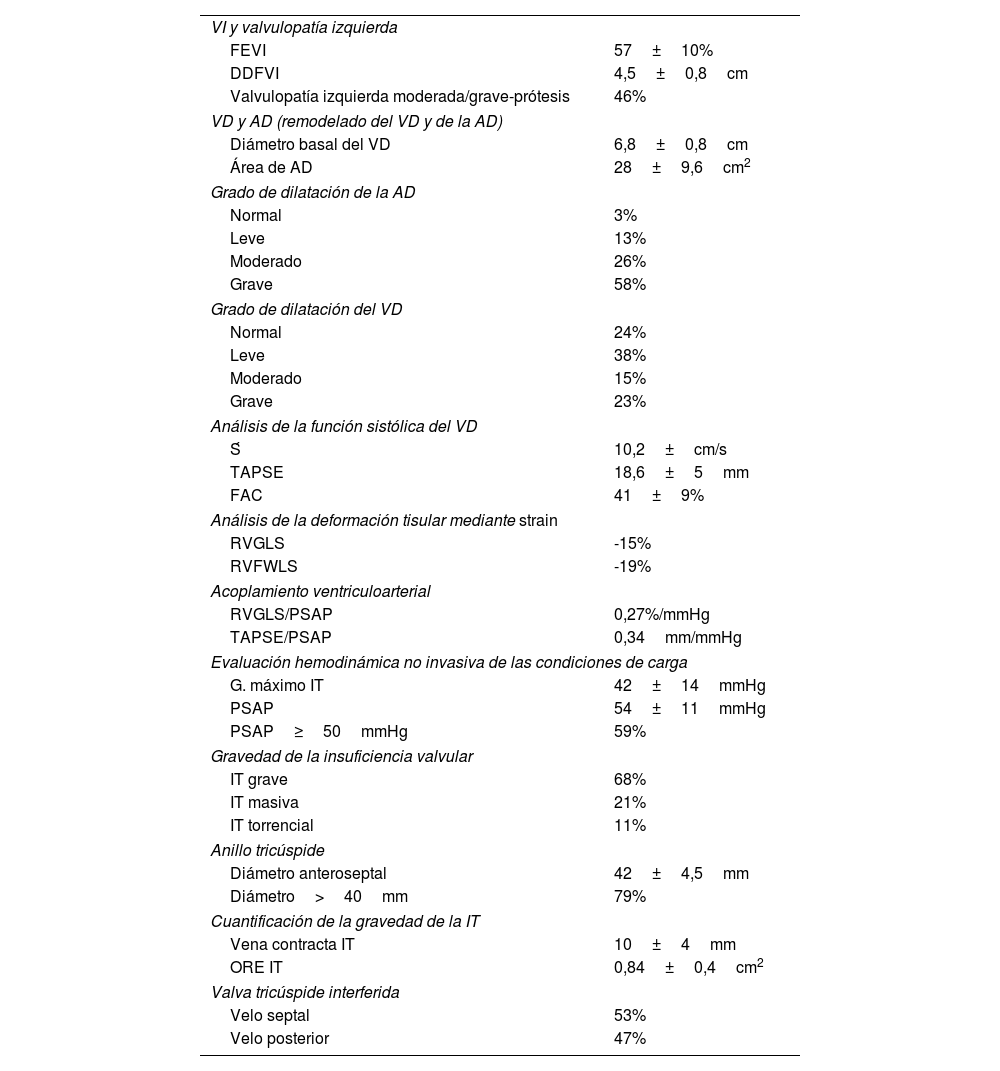La insuficiencia tricúspide (IT) inducida por el implante de dispositivos de estimulación intracardiacos (DEIC) es una causa cada vez más frecuente de IT grave. Nuestro objetivo fue describir las características ecocardiográficas de la IT grave inducida por DEIC.
MétodosEstudio de cohortes retrospectivo que incluyó a los pacientes con IT grave relacionada con DEIC diagnosticada en la unidad de imagen cardiaca de un hospital terciario español.
ResultadosUn total de 37 pacientes con IT grave inducida por la interferencia del cable/electrodo formaron nuestro grupo de estudio. La IT fue predominante grave (68%), seguida de masiva (21%) y torrencial (11%). El velo más afectado por la interferencia fue el septal. Un 58% de la muestra presentó dilatación grave de la aurícula derecha (AD) (media de área AD 28cm2). La media del anillo tricúspide fue de 42mm. Los parámetros usuales de cuantificación de la función sistólica del VD se encontraron en promedio dentro del rango normal (media TAPSE 19mm, onda S’ 10mm, FAC 41%), mientras que el strain global del VD (RVGLS -15%) y el strain de pared libre (RVFWLS -19%) se encontraron reducidos. Se evidenció un grado incipiente de desacoplamiento ventrículo/arterial pulmonar (media TAPSE/PSAP 0,34, SGLVD/PSAP 0,27%/mmHg).
ConclusionesNuestros pacientes con IT grave inducida por DEIC se caracterizan por un fenotipo heterogéneo con alta prevalencia de dilatación grave de AD y anillo tricúspide. El RVGLS, RVFWLS y el acoplamiento ventriculoarterial resultaron los parámetros más sensibles para la evaluación precoz de la disfunción sistólica del VD.
Tricuspid regurgitation (TR) induced by the implantation of cardiac implantable electronic devices (CIED) is an increasingly common cause of severe TR. Our aim was to describe the echocardiographic phenotypic characteristics of CIED-induced severe TR.
MethodsRetrospective cohort study that included patients with severe TR related to CIED diagnosed in the cardiac imaging unit of a Spanish tertiary hospital.
Results37 patients with severe TR induced by lead/electrode interference formed our study group. TR was predominantly severe (68%), followed by massive (21%) and torrential (11%). The leaflet most affected by the interference was the septal. 58% of the sample presented severe dilatation of the right atrium (RA) (mean RA area 28cm2). Mean tricuspid annulus measurement was 42mm. The usual parameters for quantifying RV systolic function were on average within the normal range (TAPSE mean 19mm, S’ wave 10mm, FAC 41%), while global RV strain (RVGLS -15%) and free wall strain (RVFWLS -19%) were found reduced. An incipient degree of ventricular/pulmonary arterial uncoupling was evident (mean TAPSE/PSAP 0.34, SGLVD/PSAP 0.27%/mmHg).
ConclusionsOur patients with CIED-induced severe TR are characterized by a heterogeneous phenotype with a high prevalence of severe RA and tricuspid annulus dilatation. RVGLS, RVFWLS, and arterial ventricular coupling were the most sensitive parameters for early assessment of RV systolic dysfunction.
Artículo
Comprando el artículo el PDF del mismo podrá ser descargado
Precio 19,34 €
Comprar ahora









